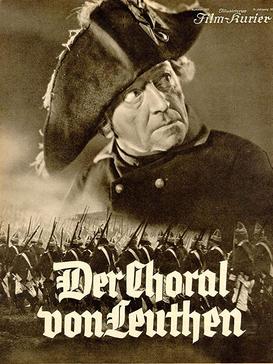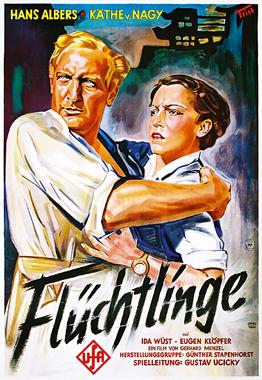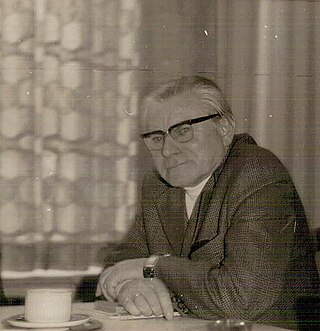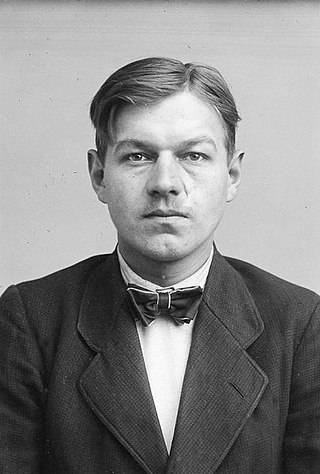
Triumph of the Will is a 1935 German Nazi propaganda film directed, produced, edited and co-written by Leni Riefenstahl. Adolf Hitler commissioned the film and served as an unofficial executive producer; his name appears in the opening titles. It chronicles the 1934 Nazi Party Congress in Nuremberg, which was attended by more than 700,000 Nazi supporters. The film contains excerpts of speeches given by Nazi leaders at the Congress, including Hitler, Rudolf Hess and Julius Streicher, interspersed with footage of massed Sturmabteilung (SA) and Schutzstaffel (SS) troops and public reaction. Its overriding theme is the return of Germany as a great power with Hitler as its leader. The film was produced after the Night of the Long Knives, and many formerly prominent SA members are absent.

The "Horst-Wessel-Lied", also known by its incipit "Die Fahne hoch", was the anthem of the Nazi Party (NSDAP) from 1930 to 1945. From 1933 to 1945, the Nazis made it the co-national anthem of Germany, along with the first stanza of the "Deutschlandlied".
Nazi songs are songs and marches created by the Nazi Party. In modern Germany, the public singing or performing of songs exclusively associated with the Nazi Party is now illegal.

Horst Ludwig Georg Erich Wessel was a member of the Sturmabteilung (SA), the paramilitary wing of the Nazi Party, who became a propaganda symbol in Nazi Germany following his murder in 1930 by two members of the Communist Party of Germany (KPD). After his death, Nazi Propaganda Minister Joseph Goebbels elevated him into a martyr for the Nazi Party.

Der Hitlerjunge Quex is a 1932 Nazi propaganda novel by Karl Aloys Schenzinger based on the life of Herbert “Quex” Norkus. The 1933 film Hitlerjunge Quex: Ein Film vom Opfergeist der deutschen Jugend was based on it and was described by Joseph Goebbels as the "first large-scale" transmission of Nazi ideology using the medium of cinema. Both the book and the film, like S.A.-Mann Brand and Hans Westmar, which were released the same year, fictionalised and glorified death in the service of the Nazi Party and Adolf Hitler.

Morgenrot is a 1933 German submarine film set during World War I.

Nazism made extensive use of the cinema throughout its history. Though it was a relatively new technology, the Nazi Party established a film department soon after it rose to power in Germany. Both Adolf Hitler and his propaganda minister, Joseph Goebbels, used the many Nazi films to promote the party ideology and show their influence in the burgeoning art form, which was an object of personal fascination for Hitler. The Nazis valued film as a propaganda instrument of enormous power, courting the masses by means of slogans that were aimed directly at the instincts and emotions of the people. The Department of Film also used the economic power of German moviegoers to influence the international film market. This resulted in almost all Hollywood producers censoring films critical of Nazism during the 1930s, as well as showing news shorts produced by the Nazis in American theaters.
Herbert Norkus was a Hitler Youth member who was killed by German Communists. He became a role model and martyr for the Hitler Youth and was widely used in Nazi propaganda, most prominently as the subject of novel and film Hitler Youth Quex.

Adolf Hitler's rise to power began in the newly established Weimar Republic in September 1919 when Hitler joined the Deutsche Arbeiterpartei. He rose to a place of prominence in the early years of the party. Being one of its most popular speakers, he was made the party leader after he threatened to otherwise leave.

S.A.-Mann Brand is a German film made around the time that Adolf Hitler became Chancellor of Germany. It was released in mid-June 1933.

The Hymn of Leuthen is a 1933 German film depicting Frederick the Great, directed by Carl Froelich starring Otto Gebühr, Olga Chekhova and Elga Brink. It was part of the cycle of nostalgic Prussian films popular during the Weimar and Nazi eras. The title refers to the 1757 Battle of Leuthen.

Refugees is the 1933 German drama film, directed by Gustav Ucicky and starring Hans Albers, Käthe von Nagy, and Eugen Klöpfer. It depicts Volga German refugees persecuted by the Bolsheviks on the Sino-Russian border in Manchuria in 1928.

Rosa-Luxemburg-Platz, formerly the Bülowplatz, is a square in Berlin-Mitte, Germany.

Bismarck is a 1940 German historical film directed by Wolfgang Liebeneiner and starring Paul Hartmann, Friedrich Kayßler, and Lil Dagover.

Eberhard Achterberg was a religious scholar, a journalist, a high-ranking Nazi official in the Amt Rosenberg and later a leading member of the German Unitarian Religious Community and school and university teacher.

The Ruler is a 1937 German drama film directed by Veit Harlan. It was adapted from the play of the same name by Gerhart Hauptmann. Erwin Leiser calls it a propagandistic demonstration of the Führerprinzip of Nazi Germany. The film's sets were designed by the art director Robert Herlth. Location shooting took place around Oberhausen and Pompeii near Naples. It premiered at the Ufa-Palast am Zoo in Berlin.
I Accuse is a 1941 Nazi German pro-euthanasia propaganda film directed by Wolfgang Liebeneiner and produced by Heinrich Jonen and Ewald von Demandowsky. It was developed to promote the involuntary euthanasia of disabled people conducted through the Aktion T4 mass murder program and to garner public support for the Nazi concept of life unworthy of life.

Hitlerjunge Quex,, is a 1933 German film directed by Hans Steinhoff, based on the similarly named 1932 novel Der Hitlerjunge Quex by Karl Aloys Schenzinger. It was released in the United States as Our Flag Leads Us Forward.
Jürgen Ohlsen was a German actor best remembered for portraying "Heini "Quex" Völker" in the 1933 Nazi propaganda film Hitlerjunge Quex.

Albrecht "Ali" Höhler was a German communist. He was a member of the Red Front Fighters Association, the street-fighters of the Communist Party of Germany. He is known for the killing of Horst Wessel, a local leader in Berlin of the Nazi Party's SA stormtroopers. After the Nazis came to power, Höhler was taken out of prison and executed by the SA. The triggerman was the Berlin SA leader Karl Ernst.
















